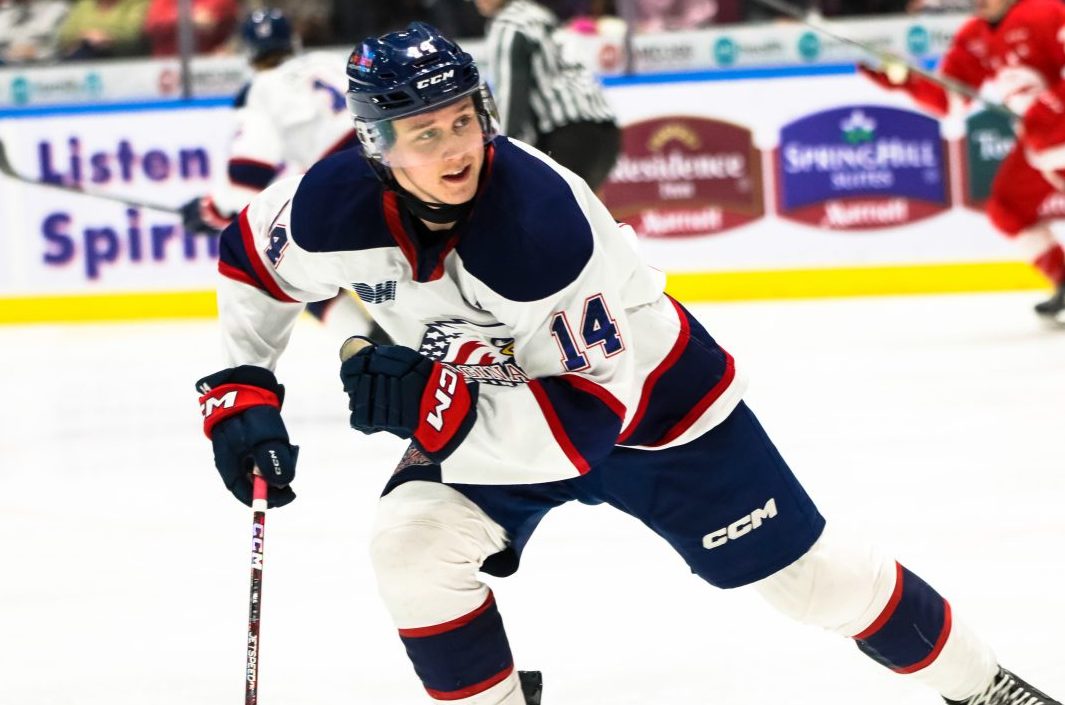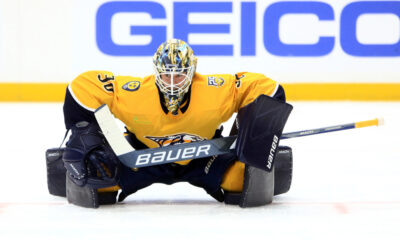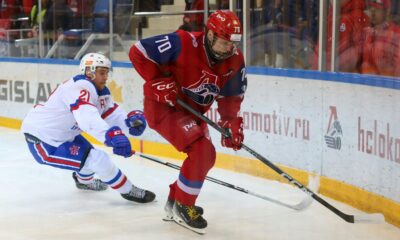A few weeks before the 2023 NHL Draft, incoming Nashville Predators GM Barry Trotz told his scouts that he wanted to take big swings with their league-most 13 picks. A few days before the draft, Trotz somewhat clarified on the 32 Thoughts podcast that he wants the team to take swings with their top picks and that later rounds can be used to find safer depth players.
Video Analysis: Nashville’s 2023 NHL Draft Part I
11 picks later, Nashville is now welcoming a new class of prospects. Meanwhile, how did Trotz’s debut draft philosophy turn out? Truthfully, it was a mix of new and old. The Predators took some swings, particularly with their first few picks, and they went the reliable route with some project picks too, potentially indicating that David Poile still had his fingerprints on his final NHL draft. So what do those swings look like and will those projects be worth it? Let’s examine.
Jesse Kiiskinen (F) | Pelicans U20 (U20 SM-sarja) | 68th overall
| Season | Team | League | GP | G | A | PTS |
| 2022-23 | Pelicans U20 | U20 SM-sarja | 31 | 20 | 23 | 43 |
| 2022-23 | Pelicans | Liiga | 7 | 0 | 1 | 1 |
| 2022-23 | Pelicans U18 | U18 SM-sarja | 2 | 1 | 1 | 2 |
| 2022-23 | Peliitat | Mestis | 1 | 0 | 0 | 0 |
Jesse Kiiskinen might be Nashville’s most underrated pick this year. I had him ranked 67th overall on my final list, so right around where he ultimately fell. On top of that, he’s already delivered some great sound bytes on the kind of game he likes to play.
In 2022-23, Kiiskinen starred for the Lahden Pelicans U20 squad, leading the team with 20 goals and 43 points in 31 games. He also appeared in seven Liiga games and added three goals and five points in five games at the U18 World Junior Championship (WJC). He’s a pest off the puck, but he’s got a great scoring touch too.
In his own zone, Kiiskinen (#74, white) is an efficient defender. He covers lots of ice and reacts to puck movements well, challenging defenders at the point and winning plenty of board battles. Off the puck, he keeps his feet moving into good supporting positions that allow him to time his breakouts just right.
Once he gets a jump in transition, Kiiskinen displays okay skating mechanics. His knee bend and posture are fine, but he could extend his strides just a tad to get even more power. Off the rush, Kiiskinen maintains really good shooting talent. He’s a forceful, accurate sniper that transfers a ton of power across his body. His deception should only improve with development too.
When he’s not driving play in transition, Kiiskinen establishes good positioning by muscling his way to the slot and keeping defenders to the outside of his blade. In around the net, he displays an underrated level of high-end puck skills.
I really appreciate how Kiiskinen positions himself off the puck when his team is driving play. Like Felix Nilsson, Kiiskinen understands the benefits of contracting ice to provide support. He gives his teammates comfortable but efficient passing options and then works hard to keep puck possession in the offensive zone, spinning off defenders and using his 6’0″ frame wisely.
Finally, Kiiskinen forechecks hard. He knows when to engage with a hit or a stick check and when to back off and pounce on a loose puck. If he misses his first chance at a takeaway, he stops and goes back for a second. On his best shifts, he’s truly relentless in his pursuit of the puck even if it comes off as clumsy at times.
At this point in his development, Jesse Kiiskinen has nailed a lot of traits of a bottom-six player at the pro level. He’s smart, but I would like to see him improve his skating, quicken his decision-making with the puck, and work on his passing skills to be able to score at the next level.
Dylan MacKinnon (D) | Halifax Mooseheads (QMJHL) | 24th overall
| Season | Team | League | GP | G | A | PTS |
| 2021-22 | Halifax Mooseheads | QMJHL | 52 | 1 | 1 | 2 |
| 2022-23 | Halifax Mooseheads | QMJHL | 61 | 6 | 17 | 23 |
The second defender taken by Nashville last week, Dylan MacKinnon is a 6’2″ right-shot blueliner playing for the Halifax Mooseheads. One look at his stat line over the past two seasons may not be the most inspiring (25 points across 113 regular season games), but that’s not the whole story.
MacKinnon (#3, white) is a modern-day shut-down defender. He’s physical, engaging any opponent standing at his net front with tie-ups, stick lifts, and cross-checks. When opposing teams gain his zone, he plasters puck carriers against the wall and smothers possession away from them.
But oftentimes, it doesn’t even get to that due to MacKinnon’s aggressive gap closure. He steps up near the blue line, taking a proper angle to the puck carrier and sweeping his stick across his body to dislodge the puck.
When he’s not closing his gaps right at the blue line, MacKinnon times his pivots well again attacking with a sweeping stick that pushes opponents to the perimeter and limits high-danger chances.
From time to time, MacKinnon misplays his defensive maneuvers, pinching too aggressively or getting beat by a skilled puck handler. But for the most part, his lives up to the shutdown billing.
The other end of the ice is where MacKinnon struggles. He’s actually a really solid skater, especially for his size, but shifts like what is shown in the clip above are more exceptions than the rule. His transition game usually stops in the neutral zone, but he has shown flashes of these coast-to-coast moments a handful of times.
His transitions usually look more like this. He’s not a super adept puck handler, managing it rather than cradling it up the ice, and his first passes are far too inconsistent. In the offensive zone, his game is fine if unspectacular. All of this begs the question: can he grow that side of his game? Either Nashville is betting on him doing so, or they think his defensive skills alone are enough for a full-time role one day.
Joey Willis (F) | Saginaw Spirit (OHL) | 111th overall
| Season | Team | League | GP | G | A | PTS |
| 2022-23 | Saginaw Spirit | OHL | 68 | 15 | 29 | 44 |
Joey Willis didn’t make my final 96-player ranking, but he was very near the cutoff. The 5’10” forward, I would say, falls into the swing category of picks whereas MacKinnon may be a safer pick. In his freshman OHL season, Willis switched between playing center and wing and scored 15 goals and 44 points in 68 games, adding six more points in 11 playoff games.
That’s some pretty impressive offensive production for your first year of junior hockey, and Willis has already shown his ability to play adept defensive hockey.
Willis (#14, white) doesn’t have blazing speed, and his accelerating steps right now grade out as NHL average. But he’s an efficient mover, anticipating puck movements well to mitigate any speed discrepancies. In the clip above, notice how he gets off the hashmark to immediately pressure the defender at the opposite point.
He forces a bad pass that disrupts the other team’s scoring chance then maintains good defensive positioning the rest of the shift. He drifts low when the puck is below the goal line while still scanning the top of the zone to ensure he’s not losing a man. He senses the puck is about to switch sides and opens his hips to receive a breakout pass.
Again, his speed in transition isn’t amazing, but it doesn’t need to be. He gains the zone, delays, and gives his teammate the perfect second to get open for a goal.
Notice Willis’ neutral-zone positioning too. He recognizes what his teammate’s plans are and creates a pressure point off of that, pouncing on the move the puck carrier has been forced into and ending their zone-entry attempt.
Regardless of the bizarre defensive choices by Guelph on this shift, Willis maintains a perfect pace through the neutral zone, finding soft ice to put the puck in the back of the net.
Early in this shift, Willis displays some creative, efficient puck skills under pressure along his defensive-zone half wall. When Saginaw’s rush falters, Willis quickly backchecks, getting inside positioning in a footrace with the Sarnia player and ultimately getting the puck back in the offensive zone.
His ability to cut the ice in half like that, and to quickly catalyze breakouts off of his sound defensive positioning, is really impressive. While his offensive game isn’t flashy right now, he already projects to be useful as a penalty killer and bottom-six option in the NHL with room to grow around the net.
Juha Jatkola (G) | KalPa (Liiga) | 121st overall
| Season | Team | League | GP | GAA | SV% | SO |
| 2021-22 | IPK | Mestis | 25 | 2.72 | 0.900 | 1 |
| 2022-23 | KalPa | Liiga | 40 | 2.16 | 0.903 | 5 |
Their first overage player of the draft, Nashville got their goalie in Juha Jatkola. The Finnish netminder was in his last year of draft eligibility, and Jeff Kealty said post-draft that the team had kept tabs on him over the past couple of seasons, but they previously felt his game hadn’t matured enough to be drafted.
Leading Finland to a silver medal at the 2023 U20 WJC, Jatkola just finished his first season as a full-time starter in the Liiga. He posted a 20-11-8 record with KalPa, notching a 0.903 save percentage and five shutouts.
At 6’1″, Jatkola doesn’t have amazing size, but he’s a very technically sound goalie. His game has shades of Juuse Saros’ with regard to their puck-tracking skills and general positioning.
Jatkola is less aggressive in positioning himself at the top of his crease, usually planting his feet just inside the blue paint for shots from a distance. That allows him to react quickly to rebound chances as shown above while still cutting down angles for shooters.
While he may not have the strongest pushes, his lateral movements are good thanks in part to his puck tracking and anticipation.
One tendency I’ve noticed is Jatkola’s use (and at times potential overuse) of the RVH technique instead of an overlap technique. It’s not so much an issue with coverage when deploying RVH, but Jatkokla’s reaction and recovery time out of that stance could improve; there were a number of goals he surrendered this year where opponents were able to exploit that timing.
Jatkola’s positioning when challenging shooters also benefits his backward mobility, which could improve with some stronger pushes. But overall, he backtracks into the net well as the puck moves deeper into the zone. To complement that, he has some room to improve his hand positioning in those adjustments. For example, notice above how his glove hand shows the corner that gets exploited during the entire rush.
Given his older age, I’d expect Jatkola to play one more season in Finland before coming to North America. I’m not sure of his NHL future, but I think he’s already the best goalie in the pipeline behind Yaroslav Askarov.
All statistics are courtesy of eliteprospects.com.

















